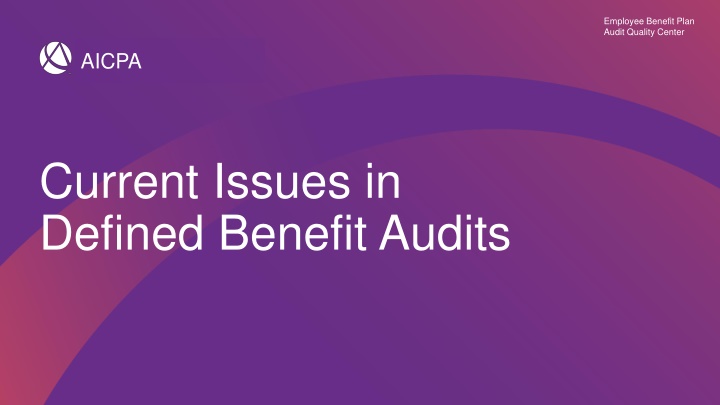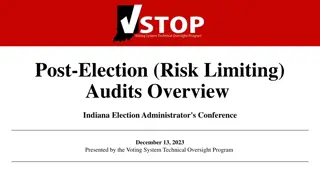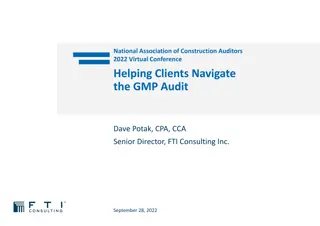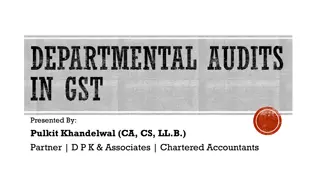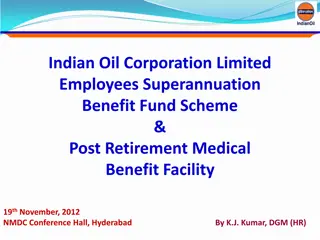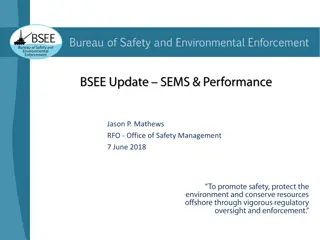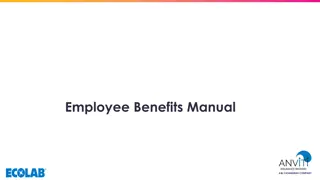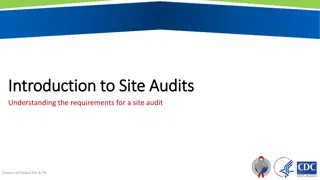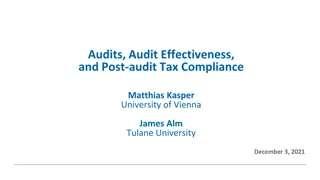Current Issues in Employee Benefit Plan Audits: A Comprehensive Overview
Dive into the latest trends and challenges in defined benefit audits, as discussed by industry experts. Explore actuarial considerations, auditor responsibilities, plan designs, and more crucial aspects in this informative webinar session.
Download Presentation

Please find below an Image/Link to download the presentation.
The content on the website is provided AS IS for your information and personal use only. It may not be sold, licensed, or shared on other websites without obtaining consent from the author.If you encounter any issues during the download, it is possible that the publisher has removed the file from their server.
You are allowed to download the files provided on this website for personal or commercial use, subject to the condition that they are used lawfully. All files are the property of their respective owners.
The content on the website is provided AS IS for your information and personal use only. It may not be sold, licensed, or shared on other websites without obtaining consent from the author.
E N D
Presentation Transcript
Employee Benefit Plan Audit Quality Center AICPA Current Issues in Defined Benefit Audits
Handouts for todays event You can download presentation slides (in PDF or PowerPoint format) and other handouts by clicking on in the toolbar at the bottom of your screen Instructions to how to obtain your CPE certificate for today s event Webinar presentation slides (both .ppt and .pdf formats) TQAs 6931.18 - .30 regarding presentation of financial statements liquidation basis for EBPs EBPAQC Topix Primer, Cash Balance Plans Summary of EBPAQC Resources and Tools
Presenters Sandi Carrier Deloitte Dennis Polisner - KPMG Michele Weldon PwC
Todays webinar Actuarial considerations Plan auditor responsibilities Mortality assumption changes Investment rate of return Plan designs Cash balance plans Derisking plans Plan terminations Annuity contracts Initial audit consideration Questions and answers
Actuarial considerations and plan designs Dennis Polisner Sandi Carrier Deloitte KPMG
Actuarial valuation report Auditor s responsibilities
Actuarial valuation report past inspection findings Pension plan measurements/obligations: Failure to include a team member (specialist) with the expertise needed to evaluate the obligation Failure to assess the actuary s (management s specialist) qualifications Failure to review the actuary s assumptions Inadequate documentation No indication that the actuarial valuation report was evaluated or reviewed with management No evaluation of the assumption for reasonableness (business, growth, discount rates, profitability)
Auditors responsibility is the pension obligation in accordance with ASC 960 Determine if the auditor has the appropriate skills, knowledge and experience in the measurement of pension benefits to complete the audit procedures. Determine if expertise in a field other than accounting or auditing is necessary to obtain sufficient appropriate audit evidence. Determine whether to use the work of an auditor s specialist. Who is needed on the team to evaluate the sufficiency and appropriateness of audit evidence obtained in forming an opinion on the financial statements.
I Need an auditors specialist! I need help I identified a specialist now what? What are my responsibilities as an auditor? Guidance: AU-C Section 620: Using the Work of an Auditor s Specialist o Agree upon responsibilities o Evaluate Competence, Capabilities, Objectivity
Auditors responsibilities using an actuarial specialist Read the actuarial report, including the census (e.g., participant counts, average age, average service, average pay, average benefit). Understand and evaluate changes in headcount Read and understand the plan document and amendments. Determine the summary of plan provisions in the report is consistent with the totality of the plan document. Understand changes in the plan demographics or other circumstances that would be expected to be reflected. Test the accuracy and completeness of census data used to develop the benefit obligation (including information underlying the determination of the accrued benefit for terminated and retired participants)
Auditors responsibilities using an actuarial specialist (continued) Valuation Methodology Test the fair value of assets. Financial Statements Assess the financial statements for mathematical accuracy and consistency with the material provided by the actuarial valuation report in the context of the requirements of ASC 960.
Evaluate the adequacy of the work of the auditor s specialist Make inquiries of the auditor s specialist Review the working papers and reports of the auditor s specialist Perform corroborative procedures, such as observe the work of the auditor s specialist; examine published data confirm relevant matters with third parties; perform detailed analytical procedures; and reperform calculations If the findings or conclusions of the auditor s specialist are not consistent with other audit evidence, engage in discussion with another specialist with relevant expertise Discuss the report of the auditor s specialist with management
Actuarial valuation report Actuary assumptions & considerations
Actuarys view of valuation process AICPA Employee Benefit Plans Conference
Actuarial assumptions Economic Demographic Expected long- term rate of return on assets Withdrawal or termination Interest/ discount rate Mortality Disability Retirement Inflation Salary scale AICPA Employee Benefit Plans Conference
Mortality Base Tables The Society of Actuaries released new mortality tables in October 2014 called the RP-2014 tables The RP 2014 tables have become almost universally adopted for most pension plans Versions of the RP 2014 include collar variations sex distinct tables Society of Actuaries (SOA) issued MP-2017 improvement scale on October 20, 2017 separate active employee versus annuitants 17
Mortality Improvement Scales (MP-2017) Incorporates mortality data from the Social Security Administration, which indicates that deaths are occurring at rates slightly higher than assumed in 2016 mortality improvement scale (MP-2016) Reflects a decrease in the rate of improvements in life expectancies in the United States compared with the data in the MP-2016 SOA did not update the RP-2014 base mortality tables Updated information should be considered for 2017 audits and any 2016 audits issued after October 20, 2017 Society of Actuaries (SOA) issued MP-2017 improvement scale on October 20, 2017 Technical Question and Answer (TIS 3700.01) [TIS 3700.01 included in webinar handout material] 18
Interest rate (ASC 960) Sources for interest rate assumption: Long-term rate of return on plan assets Settlement rate Company management Expected rates of return during the periods for which payment of benefits is deferred Consistent with returns realistically achievable on the types of assets held by the plan and the plan's investment policy Inherent in the estimated cost at the benefit information date to obtain a contract with an insurance entity to provide participants with their accumulated plan benefits Similar to ASC 715 Actuary Financial consultant Investment manager AICPA Employee Benefit Plans Conference
Long-term rate of return on plan assets Monte Carlo Simulation Building Block Historical Approaches AICPA Employee Benefit Plans Conference
Long-term rate of return on plan assets Audit considerations Forward-looking assumption? Based on analysis of expected returns correlated to the target asset allocation as of the measurement date? Review inputs to assumption (i.e., inflation factor) to determine if reasonable based on the plan investments, investing strategy and market conditions Validate individual rates for each asset class
Settlement rate Yield curve analysis Benefit obligation cashflows are applied to the yield curve Present value is calculated Solve for single equivalent discount rate that produces the same present value Bond matching Benefit obligation cashflows are compared to a hypothetical bond portfolio Bond portfolio coupons and maturities intended to match benefit obligation cashflows Benefit obligation is set to equal to the price of the hypothetical bond portfolio Discount rate is hypothetical bond portfolio internal rate of return
Settlement rate Audit considerations Review management s basis for selecting the discount rate For yield curve analyses obtain: Benefit obligation cashflows Yield curve spot rates Calculated discount rate For bond matching obtain Bond model portfolio Bond model matching results
EBPAQC Webinar on Actuarial Reports Actuarial Reports in DB Plan Audits/Using the Center s Actuarial Documentation Tool Webinar Next Wednesday, July 18th 1 3 pm ET Speakers will discuss assumptions used in actuarial report and best practices in completing EBPAQC documentation tool Registration link included in EAlert # 413
Trends in DB plan designs Cash balance plans Pension equity plans Derisking plans
Continued increase in cash balance plans Fastest growing plan type in retirement plan market * From August 3, 2017 Article, Cash Balance Retirement Plans Surge 17%, Plan Assets Rise to $1.1T, by Kravitz, Inc. More than a decade of double-digit annual growth in the cash balance plans Cash balance plans now make up 34% of all defined benefit plans up from 2.9% in 2001* In 2015, cash balance plans assets totaled $1.1 trillion with plan sponsor contributions of $29.3 billion*
Cash balance plan simplified view Hypothetical account with credits based on career or average pay or specified dollar amount Interest credits at fixed rate (e.g., 3%) or variable rated (e.g., 30- year Treasury rate) Subject to regulations on market rates Lump sum benefits equal account balance
Pension equity plan simplified view Similar to cash balance plan Benefits based on final pay and service Lump sum benefits equal final account balance
EBPAQC Topix Primer, Cash Balance Plans Primer provides information about the nature and characteristics of cash balance plans, including Cash balance plans vs. traditional defined benefit pension plans Cash balance plans vs. defined contribution pension plans Guaranteed interest rate Accumulated plan benefits and plan funding Participant accumulated benefit Plan conversions Included in webinar handout materials
Objectives of derisking Stabilize costs Reduce PBGC premiums Reduce defined benefit liabilities Place more emphasis on defined contribution plans
Common plan design changes to achieve derisking objectives Plan freeze Plan termination Convert to cash balance plan Partial plan freeze Partial plan settlements
Plan terminations and liquidation basis of accounting Sandi Carrier Deloitte
ASU 2013-07, Liquidation Basis of Accounting ASU 2013-07 (ASC 205-30) clarified when and how to use liquidation basis of accounting. Use when liquidation is imminent (remote likelihood entity will return from liquidation) and either: Approved by those in authority or imposed by other forces. Provides guidance for preparation of financial statements and disclosures under the liquidation basis of accounting. Apply prospectively from the day that liquidation becomes imminent.
ASU 2013-07, Liquidation Basis of Accounting (continued) A plan s financials prepared under the liquidation basis of accounting should contain information about its resources and obligation upon liquidation. Effects only those plans which terminate. Not applicable for mergers or partial plan terminations. Freezing a plan is not generally an event that would trigger the liquidation basis of accounting. AICPA Employee Benefit Plans Conference
ASU 2013-07, Liquidation Basis of Accounting AICPA Technical Practice Aid, Technical Questions and Answers Sections 6931.18-30 Non-authoritative guidance about the effect of FASB ASC 205- 30 Liquidation Basis of Accounting Accounting for primarily single-employer defined benefit plans and defined contribution plans although the information in certain replies may be relevant for other type of plans Includes illustrations of a single-employer DB plan using the liquidation basis of accounting Included in webinar handout materials AICPA Employee Benefit Plans Conference
AICPA Technical Practice Aid Technical Questions and Answers Sections 6931.18-30 Nonauthoritative accounting guidance: Accruing estimated income and costs expected to earn or incur through the end of liquidation Estimating fair value of investments under the liquidation basis of accounting Accruing estimated future expenses such as trustee fees, audit fees, actuarial fees, and PBGC premiums through the end of liquidation AICPA Employee Benefit Plans Conference
Presentation & disclosures liquidation basis of accounting Statement of net assets in liquidation Statement of changes in net assets in liquidation. Disclosures required under U.S. GAAP that are relevant to a user s understanding of the liquidation basis financial statements. AICPA Employee Benefit Plans Conference
Presentation & disclosures liquidation basis of accounting Disclose the following: Standard adopted Prepared using the liquidation basis of accounting Facts and circumstances surrounding the determination that liquidation is imminent. A description of the entity s plan for liquidation, including a description of each of the following: The manner by which it expects to dispose of its assets and other items it expects to sell that it had not previously recognized as assets (for example, trademarks) The manner by which it expects to settle its liabilities The expected date by which the entity expects to complete its liquidation. AICPA Employee Benefit Plans Conference
Presentation & disclosures liquidation basis of accounting Disclose the following (continued): The methods and significant assumptions used to measure assets and liabilities Disclose the present value of accumulated benefits in liquidation as of the date of termination and how determined The type and amount of costs and income accrued in the statement of net assets in liquidation and the period over which those costs are expected to be paid or income earned. AICPA Employee Benefit Plans Conference
Auditors report We have audited the accompanying financial statements of the ABC LLP Pension Plan (the Plan ), which comprise the statements of net assets available for benefits and of accumulated Plan benefits as of December 31, 2017 (in Liquidation) and 2016 (Ongoing), and the related statements of changes in net assets available for benefits in liquidation and of changes in accumulated Plan benefits for the year ended December 31, 2017, and the related notes to the financial statements. AICPA Employee Benefit Plans Conference
Auditors report Emphasis-of-matter regarding liquidation basis of accounting As discussed in Notes X, X and X to the financial statements, on December 2, 2016, the Plan Sponsor, ABC LLP (the Partnership ) authorized termination of the Plan effective December 31, 2017. In accordance with accounting principles generally accepted in the United States of America, the Plan has changed its basis of accounting from the ongoing plan basis used in presenting the December 31, 2016 financial statements to the liquidation basis used in presenting the December 31, 2017 financial statements. Our opinion is not modified with respect to this matter. AICPA Employee Benefit Plans Conference
Overall considerations in relation to termination Plan amendments (for example, to offer a lump-sum window) Changes to actuarial present value of accumulated plan benefits: Reflect the plan's present and future ability to pay benefits Changes in a plan s actuarial assumptions (expected rate of return, demographic) Census data clean-up Increased risk of fraud may need to modify nature, timing and extent of benefit payment testing to address the risk Changes in benefit payment processing (for example, increased volume of payments, form of payment [lump sums versus annuities]) Annuity Contract Purchase Residual liabilities for annuity purchases AICPA Employee Benefit Plans Conference
Annuity purchases and initial audits Michele Weldon PWC 45
Annuity purchases Annuity purchases (transfer of liability to a third party) Buy-out annuity contract - through the payment of a premium, the risk and responsibility for the payment of benefits (generally to retired participants) is transferred to an insurance entity through the purchase of individual annuity contracts for the affected participants, thus eliminating the plan and plan sponsor s pension benefit obligation. AICPA Employee Benefit Plans Conference
Settlement of obligations (group) annuity contract Audit procedures Read contract and conclude if allocated or unallocated For allocated contracts: Read contract for: Purchase price Covered individuals To conclude that risks and rewards have transferred (i.e. Plan is released from obligation) (i.e. allocated) AICPA Employee Benefit Plans Conference
Settlement of obligations (group) annuity contract Testing Ensure populationcovered under contract agrees to Plan s records, and that participants are off census data Confirm people in contract are no longer in census data Look for people on listing in contract who weren t in prior year census data Ensure data provided for participants covered under the contract agrees to Plan data. If liquidating via contract test to prior year annuity payments and current year lump sum too Vouch payment and agree to purchase price Subsequent adjustment review AICPA Employee Benefit Plans Conference
Financial statement presentation Purchase of annuity contract Annuity contract payments are shown separate from benefit payments on SCNA (ASC 960-30-45-2 (f and g)) Full price should be recognized If additional information becomes available subsequent to year end consider whether that is a recognizable subsequent event. Use guidance in ASC 855-10-25 and AU-C 560 Show reduction of obligation due to the purchase of an annuity contract (combined) with benefit payments on the SCAPB (ASC 960-20-50-6) AICPA Employee Benefit Plans Conference
